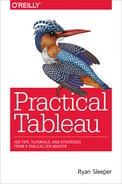Chapter 100. Tip 15: Tell a Story
Storytelling is the most powerful way to put ideas into the world today.
Robert McAfee Brown
In an ideal scenario, the stories in your data are so compelling that they are self-explanatory. Unfortunately, this is rarely the case. What’s worse, at times we are so close to the data and insights that we don’t realize that our data visualizations need additional context in order to be properly understood.
If we want our data visualizations to be understood, elicit sharing, and—eventually— cause action, we need to help tell the data-driven stories in our dashboards. Here are just a few ways to help complement a data visualization with written anecdotes:
-
In Chapter 92, I remind data visualization practitioners to “not neglect the set-up.” By adding some context to open a dashboard, you clearly communicate what your work is about. This works even better if you are able to ask a single question that the rest of your dashboard attempts to answer. This guides end users and helps them find the answer on their own, giving the discovered insights a better chance to stick with your audience.
-
I also use “inline insights” as a tactic for communicating my analysis of the data. To do this, I will simply build a text box into my data visualizations that provides real estate for me to add my own two cents about my findings and recommendations.
-
Thirdly, don’t underestimate the power of annotations. Many times, the practice of data visualization is extremely dependent on context. For example, if I am analyzing web analytics data and see a large spike in traffic, I would like to know what offline tactics may have driven the spike. I may be able to see that the spike was a result of an increase in direct traffic, but without input from advertising stakeholders, I will not be able to fully explain the trend. Perhaps our company launched a television commercial during the timeframe in question. These are the pieces of context that I like to add in the form of annotations.
-
Finally, if you have a chance to be in the room when an end user interacts with your data visualization, try to—literally—tell a story. Why did you make the visualization? What were the key findings? What actions should we take next?
With a firm grasp on the technical tactics in Tableau, a strategic approach to data visualization, and some elements of storytelling, your work will have the best-possible chance at causing positive actions.
